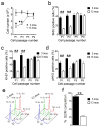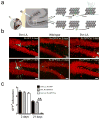Aging brain microenvironment decreases hippocampal neurogenesis through Wnt-mediated survivin signaling
- PMID: 22404871
- PMCID: PMC3350615
- DOI: 10.1111/j.1474-9726.2012.00816.x
Aging brain microenvironment decreases hippocampal neurogenesis through Wnt-mediated survivin signaling
Abstract
Accumulating evidence suggests that adult hippocampal neurogenesis relies on the controlled and continued proliferation of neural progenitor cells (NPCs). With age, neurogenesis decreases through mechanisms that remain unclear but are believed to involve changes in the NPC microenvironment. Here, we provide evidence that NPC proliferation in the adult brain is in part regulated by astrocytes via Wnt signaling and that this cellular cross-talk is modified in the aging brain, leading to decreased proliferation of NPCs. Furthermore, we show that astrocytes regulate the NPC cell cycle by acting on the expression levels of survivin, a known mitotic regulator. Among cell cycle genes found down-regulated in aged NPCs, survivin was the only one that restored NPC proliferation in the aged brain. Our results provide a mechanism for the gradual loss of neurogenesis in the brain associated with aging and suggest that targeted modulation of survivin expression directly or through Wnt signaling could be used to stimulate adult neurogenesis.
© 2012 The Authors. Aging Cell © 2012 Blackwell Publishing Ltd/Anatomical Society of Great Britain and Ireland.
Figures






Similar articles
-
Survivin, a key component of the Wnt/β-catenin signaling pathway, contributes to traumatic brain injury-induced adult neurogenesis in the mouse dentate gyrus.Int J Mol Med. 2013 Oct;32(4):867-75. doi: 10.3892/ijmm.2013.1456. Epub 2013 Jul 24. Int J Mol Med. 2013. PMID: 23900556
-
Wnt signalling regulates adult hippocampal neurogenesis.Nature. 2005 Oct 27;437(7063):1370-5. doi: 10.1038/nature04108. Nature. 2005. PMID: 16251967
-
Downregulation of survivin regulates adult hippocampal neurogenesis and apoptosis, and inhibits spatial learning and memory following traumatic brain injury.Neuroscience. 2015 Aug 6;300:219-28. doi: 10.1016/j.neuroscience.2015.05.025. Epub 2015 May 16. Neuroscience. 2015. PMID: 25987205
-
Age-dependent decline in neurogenesis of the hippocampus and extracellular nucleotides.Hum Cell. 2019 Apr;32(2):88-94. doi: 10.1007/s13577-019-00241-9. Epub 2019 Feb 7. Hum Cell. 2019. PMID: 30730038 Review.
-
Parkinson's disease, aging and adult neurogenesis: Wnt/β-catenin signalling as the key to unlock the mystery of endogenous brain repair.Aging Cell. 2020 Mar;19(3):e13101. doi: 10.1111/acel.13101. Epub 2020 Feb 12. Aging Cell. 2020. PMID: 32050297 Free PMC article. Review.
Cited by
-
Age-related changes in brain support cells: Implications for stroke severity.Neurochem Int. 2013 Oct;63(4):291-301. doi: 10.1016/j.neuint.2013.06.013. Epub 2013 Jun 28. Neurochem Int. 2013. PMID: 23811611 Free PMC article. Review.
-
Wnt/β-Catenin Signaling Pathway Governs a Full Program for Dopaminergic Neuron Survival, Neurorescue and Regeneration in the MPTP Mouse Model of Parkinson's Disease.Int J Mol Sci. 2018 Nov 24;19(12):3743. doi: 10.3390/ijms19123743. Int J Mol Sci. 2018. PMID: 30477246 Free PMC article. Review.
-
Wnt signaling in neuropsychiatric disorders: ties with adult hippocampal neurogenesis and behavior.Neurosci Biobehav Rev. 2014 Nov;47:369-83. doi: 10.1016/j.neubiorev.2014.09.005. Epub 2014 Sep 28. Neurosci Biobehav Rev. 2014. PMID: 25263701 Free PMC article. Review.
-
Targeting Wnt signaling at the neuroimmune interface for dopaminergic neuroprotection/repair in Parkinson's disease.J Mol Cell Biol. 2014 Feb;6(1):13-26. doi: 10.1093/jmcb/mjt053. Epub 2014 Jan 14. J Mol Cell Biol. 2014. PMID: 24431301 Free PMC article. Review.
-
GABAergic Regulation of Adult Hippocampal Neurogenesis.Mol Neurobiol. 2017 Sep;54(7):5497-5510. doi: 10.1007/s12035-016-0072-3. Epub 2016 Sep 6. Mol Neurobiol. 2017. PMID: 27599499 Review.
References
-
- Alvarez-Buylla A, Temple S. Stem cells in the developing and adult nervous system. J Neurobiol. 1998;36:105–110. - PubMed
-
- Caldas H, Jiang Y, Holloway MP, Fangusaro J, Mahotka C, Conway EM, Altura RA. Survivin splice variants regulate the balance between proliferation and cell death. Oncogene. 2005;24:1994–2007. - PubMed
Publication types
MeSH terms
Substances
Grants and funding
LinkOut - more resources
Full Text Sources
Other Literature Sources
Research Materials

